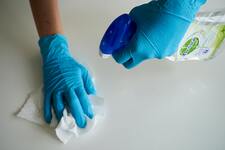You've just picked up a gorgeous piece of fabric from your favorite store. You can't wait to make it into a new piece of clothing, but before you can start sewing, it needs a good cleaning.
Don't worry, we're here to help. In this article, we'll teach you the basics of textile care so you can keep your clothes looking their best for years to come.
What Is Cleaning textiles and fabrics
Textile cleaning is the process through which fabrics and textiles are made clean and free of dirt, dust, and other particles. This is often done through a variety of methods, including vacuuming, steam cleaning, and hand-washing.
Textile cleaning is important for a number of reasons. Not only does it make your fabrics and textiles look clean and new again, but it also helps to protect them from dirt, dust, and other contaminants. Additionally, regular textile cleaning can help to preserve the fabric's color and extend its life.
Benefits of Professional Fabric Cleaning
When it comes to fabric care, professional cleaning is always the best option. By entrusting your clothes, curtains, and other textiles to the experts, you're ensuring that they'll be cleaned and cared for properly. And that, in turn, will extend their life and maintain their quality.
But there are other benefits to professional cleaning as well. For one, it can help you get rid of tough stains and odors that you might not be able to remove at home. It can also boost the colors of your fabrics, making them look fresh and new again. Plus, it can help protect your fabrics from damage caused by dirt, dust, and other pollutants in the air.
Common Textile Cleaning Techniques
Textiles can be cleaned dry, wet, or at home.
Dry cleaning is most expensive and environmentally unfriendly. A special dry-cleaning plant receives the clothes in a sealed pouch with cleaning fluid. There, fabric-safe machinery and solvents wash and press clothes.
Wet cleaning is most popular and eco-friendly. It's gentlest on clothes and works on most fabrics. The clothes are washed in a special machine with wet-cleaning detergent. The centrifugal washer uses less water and spins clothes dry.
Home cleaning is the cheapest but slowest and least effective. This method cleans clothes with your washing machine and detergent. Without specialized equipment or solvents, you risk damaging or shrinking your clothes in the wash.
How to Prevent Fabric Damage During Cleaning
To prevent fabric damage when Cleaning textiles and fabrics, there are a few key steps you can take.
- First, make sure to read the care label of your fabric. This will give you information on how to properly clean your textiles and what materials you should avoid using in the process.
- Second, pre-treat any stained or soiled areas with a mild detergent. Doing this first helps loosen the dirt, making it easier to remove during the main wash cycle.
- Third, use a gentle cycle on your washer and a mild detergent like baby shampoo or essential oils with no dyes or fragrances. Also be sure the water temperature is not too hot as this can cause damage to delicate fabrics.
- And lastly, set up a clothesline in an area that gets plenty of light and air circulation so that your fabric can dry quickly and naturally. This will help preserve its integrity and keep it looking fresh for longer. Follow these steps and you’ll be well on your way to taking your fabrics to the next level!
Choosing the Right Cleaning Product for Your Fabrics
Choosing the right cleaning product is essential for maintaining the quality of your fabrics. Depending on the type of material you are cleaning, different products should be used. For example, if you are trying to clean a delicate fabric such as silk or wool, use a mild detergent and always read the label before starting your Cleaning textiles and fabrics process.
For general materials such as upholstery and draperies, an all-purpose cleaner can be used. When dealing with delicate fabrics like silk or velvet, using a dry-cleaning solution will give you the best results. It’s also important to avoid using bleach on darker fabrics as it can cause staining and discoloration.
Overall, it’s best to choose chemical-free cleaners that don’t contain harsh abrasives that can strip away dyes or cause fading over time. If in doubt, spot test a small hidden area first before attempting to clean an entire piece of fabric; this will ensure your fabrics remain in top condition for longer.
Tips for Maintaining Cleaned Fabrics
Maintaining your fabrics is just as important as the cleaning process itself. Here are some tips to get the most out of your clean fabrics and keep them looking their best:
- Air out fabrics in direct sunlight - Direct sunlight can help remove any residual odors that may have been left after cleaning.
- Store in a cool and dry area - Storing your fabric in a cool and dry area can help prevent mold, mildew, and other types of damage.
- Vacuum regularly - Regular vacuuming helps to remove dirt, dust, and debris that has accumulated over time.
- Spot clean as needed - Spot cleaning is an effective way to remove stains and keep fabric looking fresh.
Conclusion
So there you have it: a complete guide to textile care. By following these simple tips, you can make sure your fabrics stay looking and feeling great for years to come. And remember, if you have any questions or concerns, always consult an expert or click here to know more about Cleaning textiles and fabrics.
Company Name: The Steam Team
Company Address: 9901 Burnet Rd. Austin, Texas 78758
Company Contact Number: 512-451-8326
Company Email: [email protected]
Original Source of the original story >> An Expert Guide to Cleaning textiles and fabrics






